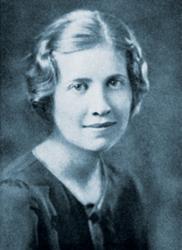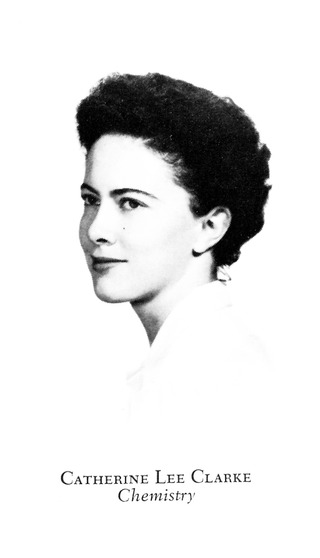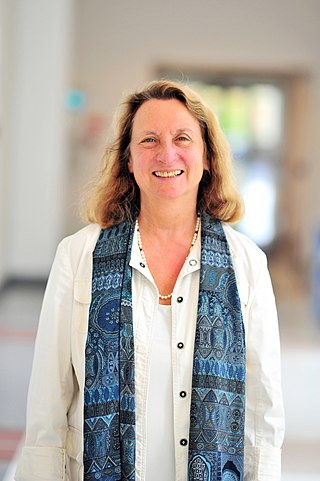Related Research Articles

Bryn Mawr College is a women's liberal arts college in Bryn Mawr, Pennsylvania. Founded as a Quaker institution in 1885, Bryn Mawr is one of the Seven Sister colleges, a group of elite, historically women's colleges in the United States, and the Tri-College Consortium along with Haverford College and Swarthmore College. Finally, it is one of 15 Quaker colleges in the United States. The college has an enrollment of about 1,350 undergraduate students and 450 graduate students. It was the first women's college to offer graduate education through a PhD.

Martha Carey Thomas was an American educator, suffragist, and linguist. She was the second president of Bryn Mawr College, a women's liberal arts college in Bryn Mawr, Pennsylvania.

Clark Richard McCauley is an American social psychologist who is Research Professor of Psychology and co-director of the Solomon Asch Center for Study of Ethnopolitical Conflict at Bryn Mawr College.
Clayton Heathcock is an organic chemist, Professor of Chemistry, and Dean of the College of Chemistry at the University of California, Berkeley. Professor Heathcock is well known for his accomplishments in the synthesis of complex polycyclic natural products and for his contributions to the chemistry community. In 1995 he became a member of the National Academy of Sciences.

Sir David William Cross MacMillan is a Scottish chemist and the James S. McDonnell Distinguished University Professor of Chemistry at Princeton University, where he was also the chair of the Department of Chemistry from 2010 to 2015. He shared the 2021 Nobel Prize in Chemistry with Benjamin List "for the development of asymmetric organocatalysis".
Arthur C. Cope was an American organic chemist and member of the United States National Academy of Sciences. He is credited with the development of several important chemical reactions which bear his name including the Cope elimination and the Cope rearrangement.
Michelle M. Francl is an American chemist. Francl is a professor of chemistry, and has taught physical chemistry, general chemistry and mathematical modeling at Bryn Mawr College since 1986.

Willey Glover Denis was an American biochemist and physiologist. She was noted particularly for her collaborations with Otto Folin, including studies of protein metabolism. She was a pioneer in the field of clinical chemistry and the measurement of protein in biological fluids (blood, urine and cerebrospinal fluid. She also developed the first reliable method of assaying lead in body tissue and waste.
Ingrid D. Rowland is a professor at the University of Notre Dame School of Architecture. She is a frequent contributor to The New York Review of Books.

Mary Peters Fieser was an American chemist best known for the many books she wrote with her husband Louis Fieser.
Marjorie Constance Caserio was an English chemist. In 1975, she was awarded the Garvan Medal by the American Chemical Society.
Dorothy Anna Hahn (1876–1950) was a lifelong educator and American professor of organic chemistry at Mount Holyoke College. Her research utilized the then newly developed technique of ultraviolet spectroscopy to study hydantoins.

Mary Hamilton Swindler was an American archaeologist, classical art scholar, author, and professor of classical archaeology, most notably at Bryn Mawr College, the University of Pennsylvania, and the University of Michigan. Swindler also founded the Ella Riegel Memorial Museum at Bryn Mawr College. She participated in various archaeological excavations in Greece, Egypt, and Turkey. The recipient of several awards and honors for her research, Swindler's seminal work was Ancient Painting, from the Earliest Times to the Period of Christian Art (1929).

Catherine Clarke Fenselau is an American scientist who was the first trained mass spectrometrist on the faculty of an American medical school; she joined Johns Hopkins School of Medicine in 1968. She specializes in biomedical applications of mass spectrometry. She has been recognized as an outstanding scientist in the field of bioanalytical chemistry because of her work using mass spectrometry to study biomolecules.
Mary Bidwell Breed was an American chemist. In 1901 she became the first female dean of Indiana University and her chemistry work with aromatic acids.

Elaine Surick Oran is an American physical scientist and is considered a world authority on numerical methods for large-scale simulation of physical systems. She has pioneered computational technology to solve complex reactive flow problems, unifying concepts from science, mathematics, engineering, and computer science in a new methodology. An incredibly diverse range of phenomena can be modeled and better understood using her techniques for numerical simulation of fluid flows, ranging from the tightly grouped movements of fish in Earth's oceans to the explosions of far-flung supernovae in space. Her work has contributed significantly to the advancement of the engineering profession.
Leila Clement Spaulding (1878-1973) was an American classicist and archaeologist who taught Greek at Vassar College (1903-1907), lectured in art and archaeology at Bryn Mawr College and was Assistant Professor of Classics at Colorado College 1911–1914. She was the first woman professor with a PhD at Colorado College. As well as her teaching responsibilities, Spaulding worked on classical sculpture publishing the book of her PhD thesis on the "Camillus"-Type in sculpture.
Elmer Peter Kohler was an American organic chemist who spent his career on the faculty at Bryn Mawr College and later at Harvard University. At both institutions he was notable for his effectiveness in teaching.
James Snyder (1928–1990) was an American art historian, specializing in northern Renaissance art. His Northern Renaissance Art of 1985 was a standard textbook on the subject for several decades, with a posthumous revised edition in 2005, revised by Larry Silver and Henry Luttikhuizen, being somewhat replaced by Jeffrey Chipps Smith's The Northern Renaissance of 2004. Snyder taught at Bryn Mawr College from 1964 until his retirement in 1989. He died of liver disease in August 1990, aged 62.
References
- ↑ "Frank B. Mallory of Bryn Mawr, Pennsylvania".
- 1 2 "In Memoriam: Dr. Frank Mallory". Bryn Mawr College Department of Chemistry.
- ↑ Cassidy, Kim (November 16, 2017). "Remembering the Distinguished Career of Long-Time Professor of Chemistry Frank Mallory".